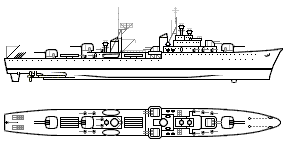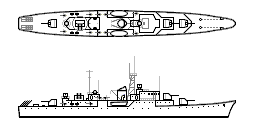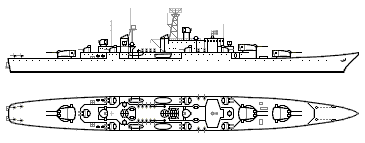You are not logged in.
Dear visitor, welcome to WesWorld. If this is your first visit here, please read the Help. It explains in detail how this page works. To use all features of this page, you should consider registering. Please use the registration form, to register here or read more information about the registration process. If you are already registered, please login here.


Quoted
Pretty sure her main armament caliber would be rated too small by RSAN experts as it would lack stopping power against fast attack craft or larger vessel a frigate might encounter, such as an AMC for example.
Quoted
Originally posted by Red Admiral
There's no real difference between SS2 and SS3v1, if anything, SS3v1 is better, with revised hull hydrodynamics and more accurate armament and misc weights.
This post has been edited 1 times, last edit by "Rooijen10" (Aug 13th 2009, 1:08pm)
Quoted
Would love to know which bugs exist that give SS3(b2) an edge over SS2.
Quoted
Originally posted by Red Admiral
Quoted
Would love to know which bugs exist that give SS3(b2) an edge over SS2.
SS3b2 is more restrictive than SS2 due to increased number of options, e.g. more shells for AAA, revised hull model. Its only really in deck armour where there is a real change as SS2 averages over the entire waterplane area whilst SS3b2 splits this into distinct chunks (foredeck, main deck, quarterdeck).
I think SS3b3 still has some problems with it. Ian is slowly progressing but has other commitments.
Quoted
Originally posted by Hrolf Hakonson
I haven't noticed any real problems with SS3b3, it's more that you have to enter a few more things than you're used to and it will complain if you don't in a way that's not really very clear. I really like the ability to set your light gun ammunition, and the increased ability to lay out your guns. The hull modeling improvements are also noticeable, especially with longer-ranged ships, where you may find that transom sterns AREN'T the way to go even for faster designs.
Quoted
Originally posted by Brockpaine
Quoted
Originally posted by Hrolf Hakonson
I haven't noticed any real problems with SS3b3, it's more that you have to enter a few more things than you're used to and it will complain if you don't in a way that's not really very clear. I really like the ability to set your light gun ammunition, and the increased ability to lay out your guns. The hull modeling improvements are also noticeable, especially with longer-ranged ships, where you may find that transom sterns AREN'T the way to go even for faster designs.
I've played around only briefly with it, but this seems to match my opinion of it, too. I've tried to sim a few SS2 designs I've made in SS3, and I was generally able to come fairly close on the light tonnage, too. I still haven't figured out that "beam between bulkheads" issue because SS3 wails that I keep doing it wrong. I think it's was the beam between the inside bulkheads of the TDS, but I've never seen anyone explain it before.
Quoted
I too like the ability to set the light gun ammo and fuss with the gun layouts. Makes things wonderfully easy.
Quoted
Originally posted by Hrolf Hakonson
Quoted
Originally posted by Brockpaine
Quoted
Originally posted by Hrolf Hakonson
I haven't noticed any real problems with SS3b3, it's more that you have to enter a few more things than you're used to and it will complain if you don't in a way that's not really very clear. I really like the ability to set your light gun ammunition, and the increased ability to lay out your guns. The hull modeling improvements are also noticeable, especially with longer-ranged ships, where you may find that transom sterns AREN'T the way to go even for faster designs.
I've played around only briefly with it, but this seems to match my opinion of it, too. I've tried to sim a few SS2 designs I've made in SS3, and I was generally able to come fairly close on the light tonnage, too. I still haven't figured out that "beam between bulkheads" issue because SS3 wails that I keep doing it wrong. I think it's was the beam between the inside bulkheads of the TDS, but I've never seen anyone explain it before.
That's exactly what it is. It basically tells the program how much width you're devoting to the TDS, which affects how much space there is in the hull for other things and how long your belt needs to be to cover those things. But if you don't enter it in a way it understands, SS WILL wail and carry on.
Quoted
Originally posted by Hrolf Hakonson
Quoted
I too like the ability to set the light gun ammo and fuss with the gun layouts. Makes things wonderfully easy.
Yep. And I like the ability to set barrel lengths in the sim itself. I haven't looked too closely to see if that affects the weight, but even if it doesn't it makes reading things easy.
Quoted
Still need to find out how much space makes a well-designed TDS

Quoted
but it seems needlessly expensive and large for taking on the DD role.
Forum Software: Burning Board® Lite 2.1.2 pl 1, developed by WoltLab® GmbH
